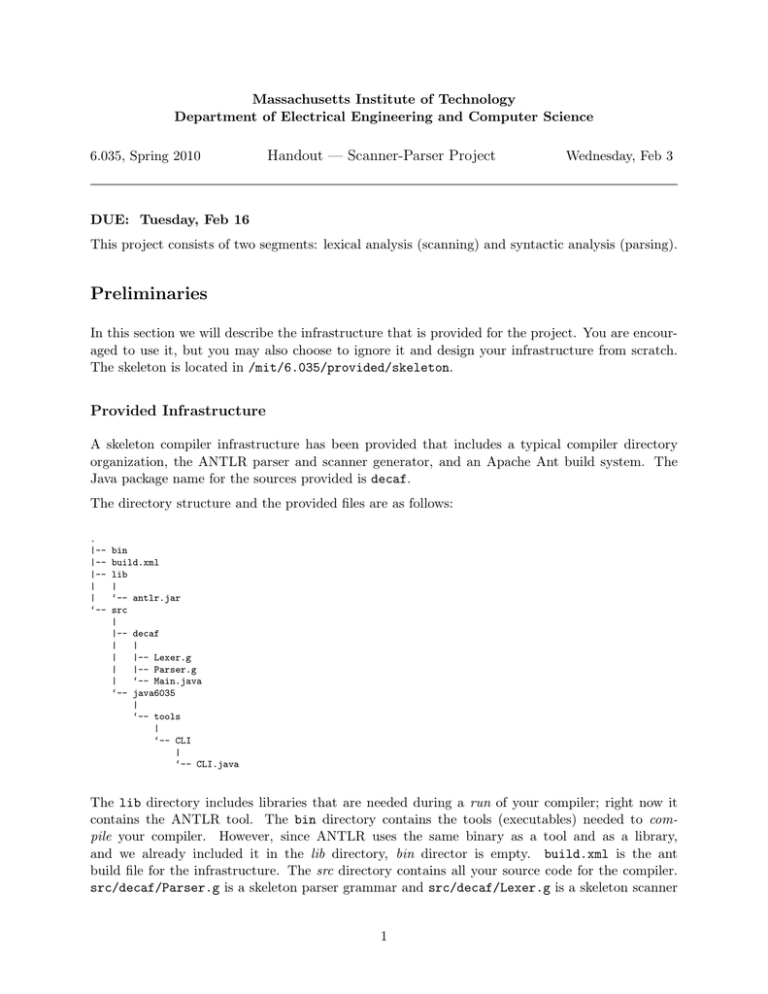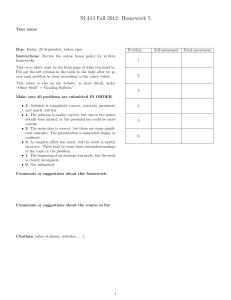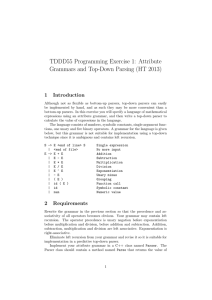Document 13441950
advertisement

Massachusetts Institute of Technology Department of Electrical Engineering and Computer Science 6.035, Spring 2010 Handout — Scanner-Parser Project Wednesday, Feb 3 DUE: Tuesday, Feb 16 This project consists of two segments: lexical analysis (scanning) and syntactic analysis (parsing). Preliminaries In this section we will describe the infrastructure that is provided for the project. You are encour­ aged to use it, but you may also choose to ignore it and design your infrastructure from scratch. The skeleton is located in /mit/6.035/provided/skeleton. Provided Infrastructure A skeleton compiler infrastructure has been provided that includes a typical compiler directory organization, the ANTLR parser and scanner generator, and an Apache Ant build system. The Java package name for the sources provided is decaf. The directory structure and the provided files are as follows: . |-|-|-| | ‘-- bin build.xml lib | ‘-- antlr.jar src | |-- decaf | | |-- Lexer.g | |-- Parser.g | ‘-- Main.java | ‘-- java6035 | ‘-- tools | ‘-- CLI | ‘-- CLI.java The lib directory includes libraries that are needed during a run of your compiler; right now it contains the ANTLR tool. The bin directory contains the tools (executables) needed to com­ pile your compiler. However, since ANTLR uses the same binary as a tool and as a library, and we already included it in the lib directory, bin director is empty. build.xml is the ant build file for the infrastructure. The src directory contains all your source code for the compiler. src/decaf/Parser.g is a skeleton parser grammar and src/decaf/Lexer.g is a skeleton scanner 1 grammar. src/decaf/Main.java is the skeleton driver and src/java6035/tools/CLI/CLI.java is the command-line interface library. To access and build the provided infrastructure, you must add the following lockers to your file system. add add add add add add 6.035 java_v1.6.0_18 gnu sipb git eclipse-sdk The eclipse-sdk locker is optional and it adds the eclipse IDE. No changes to your $CLASSPATH vari­ able are required, but due to an interaction between sipb and java v1.6.0 18, we recommend that you set an environment variable JAVA HOME to /afs/athena.mit.edu/software/java v1.6.0 18/; all the classes and jar files required for compilation are included by the Ant build file (see next Section). Ant Build System Please review the Ant build file, build.xml, that is provided. For more information on Ant, please visit: http://ant.apache.org/ To build the system, execute ant from the root directory of the system. The build file includes tasks for running ANTLR on your scanner and parser grammars, compiling the sources, packaging the compiler into a jar file, and cleaning the infrastructure. The default rule is for complete compilation and jar creation. The build file creates three directories during compilation: classes, java, and dist. The classes directory contains all .class files created during compilation. The java directory contains all the generated sources for the compiler (from scanner and parser grammars). The dist directory contains the jar archive file for the compiler and any other runtime libraries that are necessary for running the compiler. A clean will delete these three directories. If you are using revision control, you should not add these directories to your repository. Getting Started A good place to start would be to create a copy of the provided skeleton and create a git repository to track your changes. This can be accomplished with the following commands on athena: # initial setup: add 6.035 java_v1.6.0_18 gnu sipb git cp -r /mit/6.035/provided/skeleton ~/Private/6.035 cd ~/Private/6.035 git init 2 *Athena is MIT's UNIX-based computing environment. OCW does not provide access to it. # save all changes into git repository: git add . git commit -m "initial commit" # build: ant # run scanner: java -jar dist/Compiler.jar -target scan -debug /mit/6.035/provided/scanner/char1 # run parser: java -jar dist/Compiler.jar -target parse -debug /mit/6.035/provided/parser/legal-01 Scanner Your scanner must be able to identify tokens of the Decaf language, the simple imperative language we will be compiling in 6.035. The language is described in the Decaf Language Handout. Your scanner should note illegal characters, missing quotation marks, and other lexical errors with rea­ sonable error messages. The scanner should find as many lexical errors as possible, and should be able to continue scanning after errors are found. The scanner should also filter out comments and whitespace not in string and character literals. You will not be writing the scanner from scratch. Instead, you will generate the scanner using ANTLR. This program reads in an input specification of regular expression-like syntax (grammar) and creates a Java program to scan the specified language. More information on ANTLR (including the manual and examples) can be on the web at: http://antlr2.org/doc/index.html http://www.antlr.org/wiki/display/CS652/CS652+Home To get you started, we have provided a template in /mit/6.035/provided/skeleton/src/decaf/Lexer.g If you chose to work from this skeleton, you must complete the existing ANTLR rules and add new ones for your scanner. ANTLR generated scanners throw exceptions when they encounter an error. Each exception in­ cludes a text of a potential error message, and the provided skeleton driver prints them out. You are free to use use the messages provided by ANTLR, if you have verified that they make sense and are specific enough. ANTLR is invoked by the antlr task of the Ant build file. The generated files, DecafLexer.java, etc, are placed in the java/decaf directory by the task. Note that ANTLR merely generates a Java source file for a scanner class; it does not compile or even syntactically check its output. Thus, typos or syntactic errors in the scanner grammar file will be propagated to the output. 3 An ANTLR generated scanner produces a string of tokens as its output. Each token has the following fields: type text line col the the the the integer type of the token text of the token line in which the token appears column in which the token appears Every distinguishable terminal in your Decaf grammar will have an automatically generated unique integer associated with it so that the parser can differentiate them. These values are created from your scanner grammar and are stored in the *TokenTypes.java file created by ANTLR. Parser Your parser must be able to correctly parse programs that conform to the grammar of the Decaf language. Any program that does not conform to the language grammar must be flagged with at least one error message. As mentioned, we will be using the ANTLR LL(k) parser generator, same tool as for the Scanner. You will need to transform the reference grammar in Decaf Language Handout into a grammar expressed in the ANTLR grammar syntax. Be careful with checking your spelling, as ANTLR does match rule uses to declarations. Your parser does not have to, and should not, recognize context-sensitive errors e.g., using an integer identifier where an array identifier is expected. Such errors will be detected by the static semantic checker. Do not try to detect context-sensitive errors in your parser. However, you might need to create syntactic actions in your parser to check for some context-free errors. You might want to look at Section 3 in the “Tiger” book, or Sections 4.3 and 4.8 in the Dragon book for tips on getting rid of shift/reduce and reduce/reduce conflicts from your grammar. You can tell ANTLR to print out the parse states (useful for resolving conflicts) by adding trace="yes" to the ANTLR target (please see the build file). 4 What to Hand In Projects should be submitted electronically through stellar. You should submit a gzipped tar file named LASTNAME-parser.tar.gz, where LASTNAME is replaced with your last name. The contents of this file should follow the following structure: LASTNAME-parser.tar.gz | ‘-- LASTNAME-parser | |-- code | | | ... | |-- doc | | | ... | ‘-- dist | ‘-- Compiler.jar (full source code, can build by running ‘ant‘) (write-up, described in project overview handout) (compiled output, for automated testing) It is expected that most (or all) students will use Java for their project, and thus should adhere to the above format. If you elect to use a language other than Java, you must provide a wrapper script ./run.sh (runnable with bash) in the main directory that calls your code and accepts the same arguments described in the project overview handout. Any additional dependencies and instructions to build your code should be included in the documentation. Scanner output format When -target scan is specified, the output of your compiler should be a scanned listing of the program with one row for each token in the input. Each line will contain the following information: the line number (starting at 1) on which the token appears, the type of the token (if applicable), and the token’s text. Please print only the following strings as token types (as applicable): CHARLITERAL, INTLITERAL, BOOLEANLITERAL, STRINGLITERAL and IDENTIFIER. For STRINGLITERAL and CHARLITERAL, the text of the token should be the text, as appears in the original program, including the quotes and any escaped characters. Each error message should be printed on its own line, before the erroneous token, if any. Such messages should include the file name, line and column number on which the erroneous token appears. Here is an example table corresponding to print("Hello, World!");: 1 1 1 1 1 IDENTIFIER print ( STRINGLITERAL "Hello, World!" ) ; You are given both a set of test files on which to test your scanner and the expected output for these files (see next Section). The TA requests that the output of your scanner matches the provided output exactly on all files without errors (successful exit status of the diff command). The TA would like to automate the grading process as much as possible. 5 Parser output format When -target parse is specified, any syntactically incorrect program should be flagged with at least one error message, and the program should exit with a non-zero value (see System.exit()). Multiple error messages may be printed for programs with multiple syntax errors that are amenable to error recovery. Given a syntactically valid program, your parser should produce no output, and exit with the value zero (success). The exact format for parse error messages is not stipulated. Provided Test Cases and Expected Output The provided test cases for scanning and parsing can be found in: /mit/6.035/provided/scanner /mit/6.035/provided/parser The expected output for each scanner test can be found in: /mit/6.035/provided/scanner/output We will test your scanner/parser on these and a set of hidden tests. You will receive points depending on how many of these tests are passed successfully. In order to receive full credit, we also expect you to complete the written portion of the project as described in the Project Overview Handout. 6 A Why we defer integer range checking until the next project When considering the problem of checking the legality of the input program, there is no fundamental separation between the responsibilities of the scanner, the parser and the semantic checker. Often, the compiler designer has the choice of checking a certain constraint in a particular phase, or even of dividing the checking across multiple phases. However, for pragmatic reasons, we have had to divide the complete scan/parse/check unit into two parts simply to fit the course schedule better. As a result, we will have to mandate certain details about your implementations that are not necessarily issues of correctness. For example, one cannot completely check whether integer literals are within range without constructing a parse tree. Consider the input: x+-2147483648 This corresponds to a parse tree of: + / \ x ­ | INT(2147483648) We cannot confirm in the scanner that the integer literal -2147483648 is within range, since it is not a single token. Nor can we do this within the parser, since at this stage we are not constructing an abstract syntax tree. Only in the semantic checking phase, when we have an AST, are we able to perform this check, since it requires the unary minus operator to modify its argument if it is an integer literal, as follows: + / \ ----> x | INT(2147483648) + / \ x INT(-2147483648) Of course, if the integer token was clearly out of range (e.g. 99999999999) the scanner could have rejected it, but this check is not required since the semantic phase will need to perform it later anyway. Therefore, rather than do some checking earlier and some later, we have decided that ALL integer range checking must be deferred until the semantic phase. So, your scanner/parser must not try to interpret the strings of decimal or hex digits in an integer token; the token must simply retain the string until the semantic phase. When printing out the token table from your scanner, do not print the value of an INTLITERAL token in decimal. Print it exactly as it appears in the source program, whether decimal or hex. 7 MIT OpenCourseWare http://ocw.mit.edu 6.035 Computer Language Engineering�� Spring 2010 For information about citing these materials or our Terms of Use, visit: http://ocw.mit.edu/terms.



